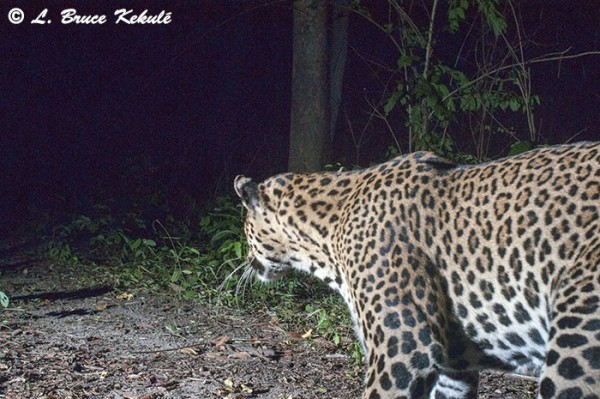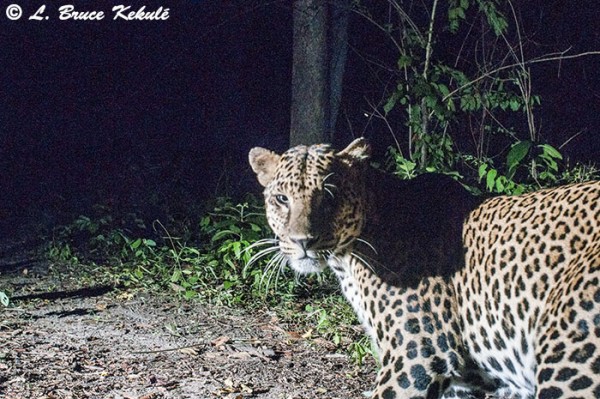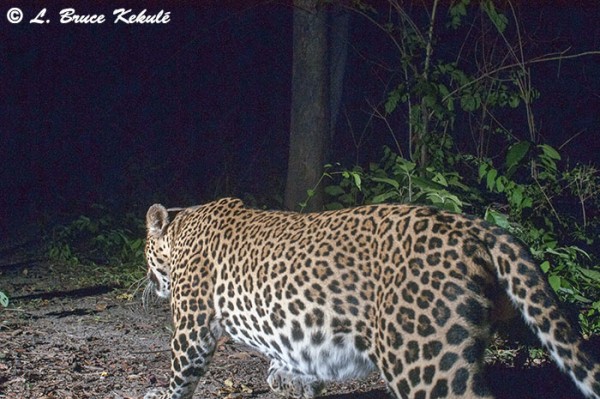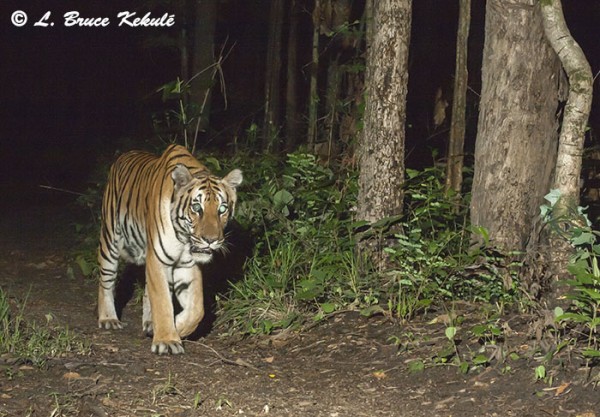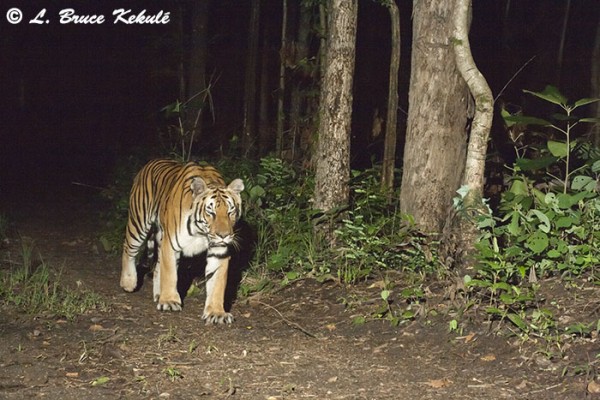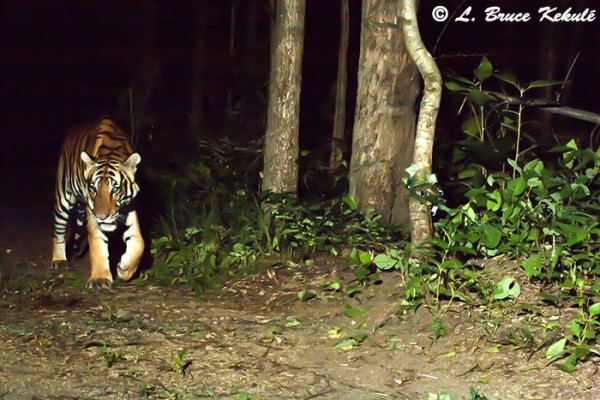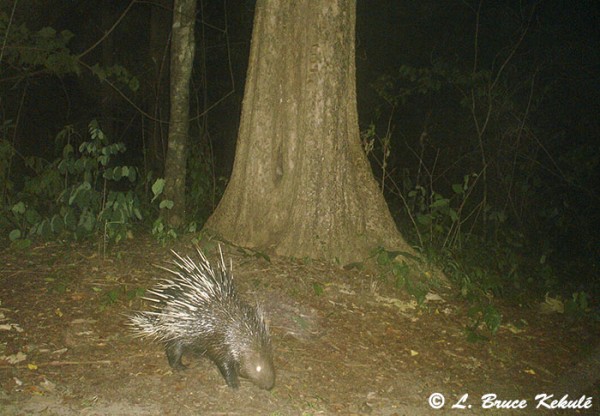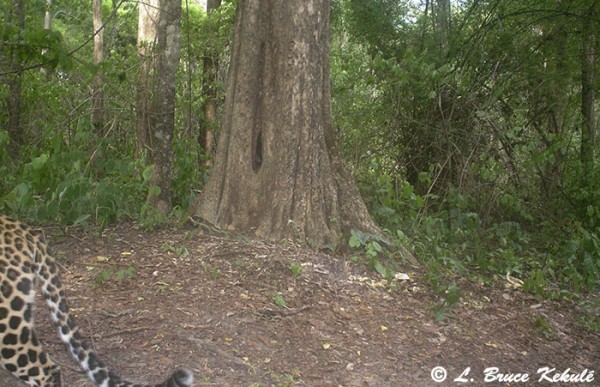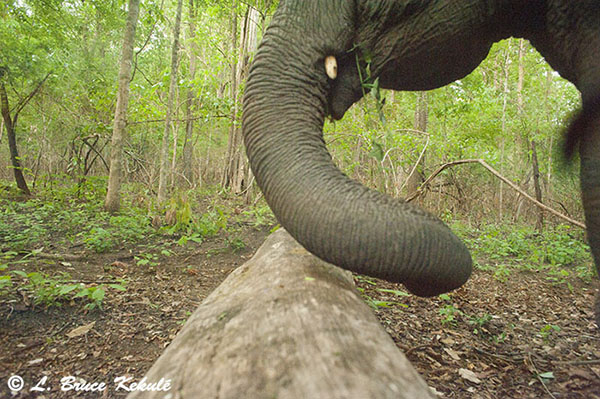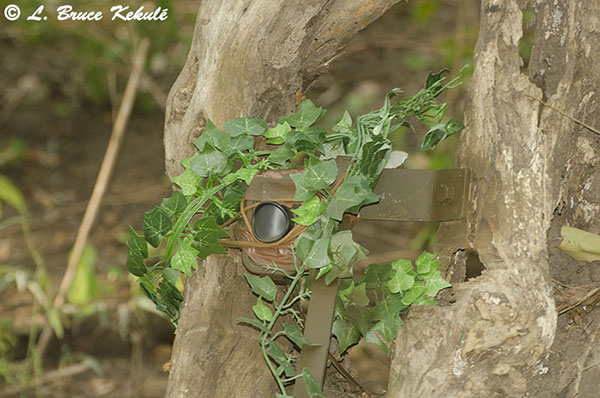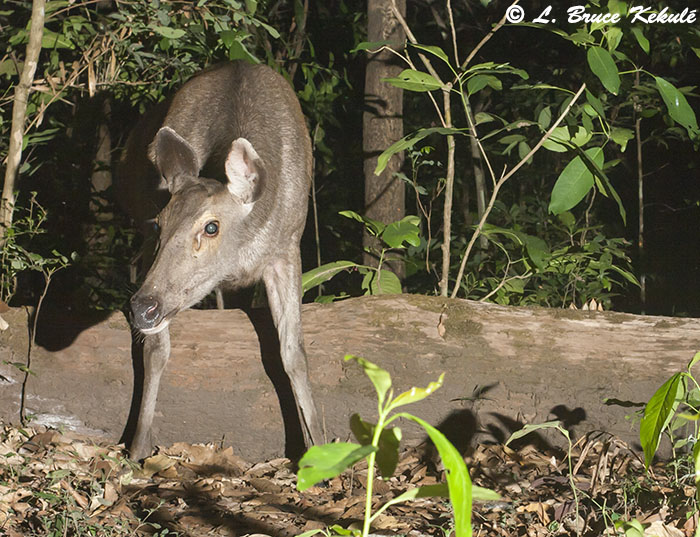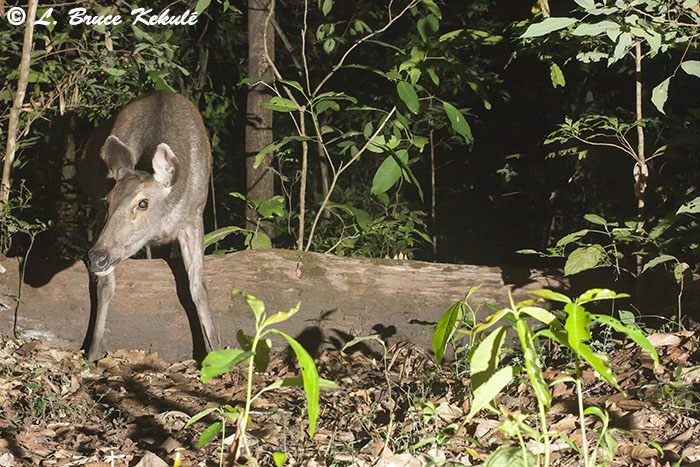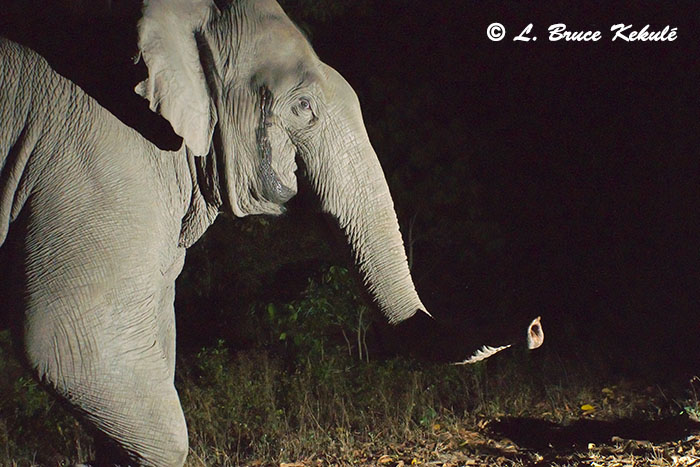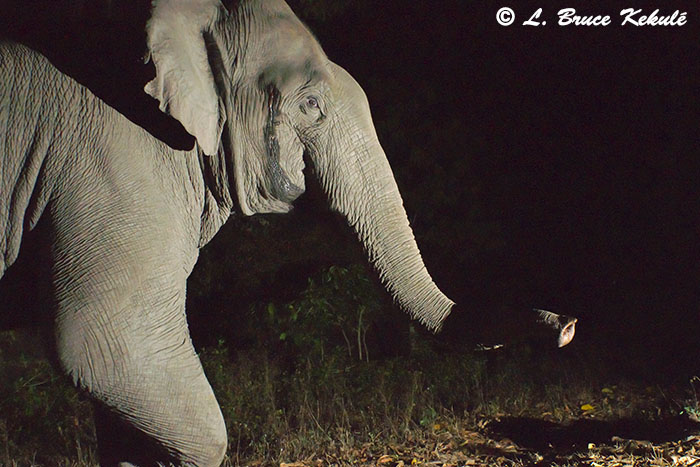Posts Tagged ‘camera-trap’
Nikon D300s catches an Asian Leopard
A male cat shows off its family jewels…!
A male leopard with its reproductive organs in full swing…Shot No: 6.
Back at the end of June, I pulled a card from my D300s DSLR trail cam at the ‘big cat trailhead’ and when I looked, I did not see anything so I threw the card in the with the rest of my CF cards.
Shot No: 1
It was somehow put into my D3s but fortunately I did not format it. After doing some work while in the forest last week, I pulled both cards (Nikon D3s had two CF card slots) and downloaded them.
Shot No: 2
Imagine my surprise…! There was a male leopard and he had been captured at night while walking past the D300s. Where the heck did that come from…?
Shot No: 3
I guess my short-term memory is on the blink. Unfortunately, the other two flashes were dead creating a horrible shadow…!
Shot No: 4
Needless to say, I’m lucky I did not lose these shots and of course, shot No: 6 is my favorite…enjoy…!
Shot No: 5
Nikon D300s set to low continuous.
Nikon 35mm manual lens.
ƒ11 @ 1/125 ISO 400
Single SB-28 set to full (the other two flashes did not fire and were dead).
SSII sensor #6 chip – Pelican 1150.
Indochinese tiger ‘eye lash’ speed…!
A Canon 400D trail cam catches a male tiger
Old green eyes’…out on a ‘night prowl’…1st shot…!
A couple of days ago, I was checking my cams and got to my Canon 400D on a forest road somewhere in the Western Forest Complex of Thailand. When I got to the cam, it was still working but only one flash three feet above the cam was firing hence the ‘eye-shine’ . The other two flashes were dead…! Life on two Canon Lithium batteries in 30 second power save mode is excellent so I left them just to see how long they would really last….!
Tiger squinting…..2nd shot.
The flash that fired was a SB-26 which I normally set for slave but somehow the settings was on full-power…needless to say, I was delighted and did back-flips when I saw a tiger again, in about the same position as the female back in June in two shots. In both instances, the tigers had their eyes open on the first shot and squinted by the second in almost the same positions. This reaction time is measured in milliseconds…!
Last month’s female tiger…..1st shot.
Then they both jumped out of the frame before the camera could shoot again. This is 100% luck….also shifted the 400D over a tad to the left for better composition. I have included last month’s female tiger shots so a comparison can be made without having to flip back to the old post.
Female squinting…..2nd shot.
All I can say, it boggles the mind but shows how fast tigers can react……Enjoy…!
Canon 400D set to continuous
Nikon 50mm ƒ1.4 manual lens
Nikon SB-26 set to full power.
1/125 – ƒ8 ISO 400.
SSII sensor #6 chip – Pelican 1150
1st shot – cropped and the rest normal size.
Sony P41 trail cam catches Asian wildlife
Leopard, bear, elephant and other rare creatures caught by a home brew ‘point and shoot’ camera trap
A black-phase leopard.
As I was in the forest checking my DSLRs last month, this little area where I park my truck looked like it might be promising and most likely used by some cryptic wildlife. I decided to setup my old Sony P41/BF board/Pelican 1040 with two ‘C’ cell externals (built for me by Dave, the old owner of BFOutdoors.com).
A yellow-phase male leopard.
An Asian black bear.
The cam is encased in an ‘elephant proof’ box attached to a tree and locked down with a Python cable. I’ve had this cam since 2008 and it’s still working very well. I usually carry a few of my old ‘point-n-shoots’ in the truck in case I need to survey a new trail or location like this.
A female muntjac (barking deer).
A green peafowl.
A couple weeks later, I was back and found a whole slew of animals had come by. A black leopard was the first through followed by a yellow-phase leopard, a muntjac (barking deer) and then a black bear. Other creatures that also came were green peafowl, elephant, large Indian civet, porcupine, several smaller civets and finally the tail end shot of a leopard again in daytime.
An Asian elephant – some strange flare.
Even though some of these photos are not the best, they are a good indication of what passes through. I previously got a tiger 50 meters from here. I have already decided to set-up a DSLR across from this tree and worked out where the flash and sensor positions would go…it looks very promising….I just gotta get back there…to be continued…!
A large Indian civet.
An Asian porcupine.
The tail-end of a leopard.
Sony A500 trail cam catches gaur bull
A young bull at a mineral deposit in the Western Forest Complex of Thailand
This is my first capture with the Sony A500 DSLR trail cam at this new location. Loads of wild cattle including gaur and banteng plus other large mammals like tiger and elephant come to this deposit for minerals. Unfortunately, the flashes did not go off and I have pulled the unit to change out the sensor (SSII) which has been tripping as if refresh is actuating the cam. I was lucky to get this shot as the rest of the frames are empty. I believe the chip is the old #5 hence the camera is tripping till the card is full and the flashes went dry…The 28mm lens however, seems OK for the large herbivores and carnivores at this setup.
Look what I missed…!
Last month, an elephant destroyed one of my slave flashes on the D700 causing a shut down of the system due to a short in the flash cable. I left the cam for awhile longer with only two slaves but nothing crossed over the ‘tiger log’. I then decided to bring the setup to Bangkok to repair the third flash. I left a Bushnell Trophy Cam in place to see what wildlife would come to the ‘tiger log’.
Well as luck will have it, an Asian black bear (Ursus thibetanus) came up to the log but did not cross. Some thirty minutes later, a yellow phase leopard (Panthera pardus) jumped up on the log and posed. The next day, a tiger (Panthera tigris) passed by very quickly proving once again that this location continues to produce images of Thailand’s top predators on a regular basis.
My D700 is now back on the log and was working well when I left it two days ago. It is hoped that the ‘big cats’ will continue to cross over the log and trip the sensor…
Flash Attack
Nikon D700 catches a male leopard on one paw…!
A big cat crossing the ‘tiger log’
Male leopard shot #1.
Male leopard on one paw….shot #2.
Male elephant – the flash destroyer.
Elephant back for more.
Banteng bull.
Evert year, forest fires occur in Thailand’s ‘Western Forest Complex’ during the dry season usually started by the human population living around the protected areas. Occasionally, lightning ignites fires but this natural phenomena, is less frequent. Stray cigarette butts also account for many fires. For the most part, local poachers start them to allow long distance spotlighting during the night. With the brush gone, they are able to see the reflection in the eyes distinctly (usually deer) with their headlamps.
Occasionally these fires are fierce and any camera trap left in the forest during this time will likely be destroyed. I always move my cams to evergreen forests from about February through to April that normally do not have fire, and this year was no different. But as soon as the first monsoon rains come in mid-April, the forest is safe once again for camera trapping.
With the first good rains through, I decided to setup my Nikon D700 back on the log. This time the cam is using a hardwired SSII sensor (Snapshotsniper.com) with a 10-meter cable setup in the tree stump apposite the cam. Also, a third flash was added and installed above the cam’s ‘elephant proof ‘ box. However, the ‘third flash’ is now history as a young tusker found it and turned it into rubble (below) but the cam, the sensor and two other flashes survived.
It was great to see this male leopard cross over the log. The first image is a good record shot but the second one is really something special catching this mature predator on one paw with the other three in mid-air. Also, the reproductive organ is sharp and just hanging there with its tail is balancing the big cat. He looks like he is winking at the cam. Once again, within two shots, the leopard turned his head to see what the flash was all about just like my tiger in late January 2014. The speed and reaction time of these felines is legendary and it doesn’t get any better…!
I also got the elephant that destroyed the third flash plus a banteng bull that stopped short but did not cross over. All in all, it was a great start to a new season at the ‘tiger log’. The full-frame D700 firing off a two-shot burst is in its element with a 28mm lens but now with only two flashes thanks to the forest giant. I have installed a 35mm lens this time to see what a tighter crop will do. Enjoy..!
Damaged SB-28 flash.
Nikon D700 setup on the log.
Hardwired external SSII (Snapshotsniper.com) sensor.
Hardwired Nikon SB-28 flash setup.
*****************************************
D700 settings: ƒ8 – 1/125 at ISO 400.
Edited in Adobe Camera Raw.
Leopard shot #1: full-frame.
Leopard shot #2: cropped.
Elephant and banteng bull: full-frame.
Sony A500 trail cam catches a wild elephant in ‘musth’
You never know what might show-up at a DSLR but when in elephant country, it’s pretty certain the big herbivore will pass the cam. However, this middle-aged wild male elephant was in a state of ‘musth’, a serious natural affliction. It would be a disaster if you bumped into this guy in the forest. Better to catch him with a trail cam…much safer..!
‘Musth’ is known to affect both wild and domestic elephants. It is an extremely dangerous time to be around one when it occurs characterized by highly aggressive behavior and accompanied by a large rise in reproductive hormones. A smelly liquid seeps from the temporal gland and sometimes into the mouth. These males have headaches causing severe pain. Needless to say, it was a great catch, something that is not documented to often, specially in the wild…! Enjoy..!!
Canon 400D DSLR catches an elephant’s trunk
A new location waiting on tiger…!
Elephant’s trunk right next to the SSII sensor hidden at the base of a tree.
It has taken awhile to get this trail cam working but it’s finally tripping well at a well-known tiger trail with plenty of battery life left in the cam and flashes after some two weeks in the field. This elephant was the first creature to cross in front of the external sensor set close to the log, and the Canon with two hard-wired SB-28s seems to be right on. I think the 400D with a Nikon 50mm ƒ1.4 manual lens looks perfect for tiger (settings: ISO 400 – ƒ8 @ 1/125). I have since added a third flash to help reduce any more shadows but that will have to wait till my next field trip next week. I look forward to checking this cam and evaluate if the third flash is really needed, and to readjust composition up a tad. Enjoy.
Canon 400D in an ‘elephant proof’ aluminum box with three Nikon SB-28 hard-wired flashes.
LBK testing the sensor and focus..!



